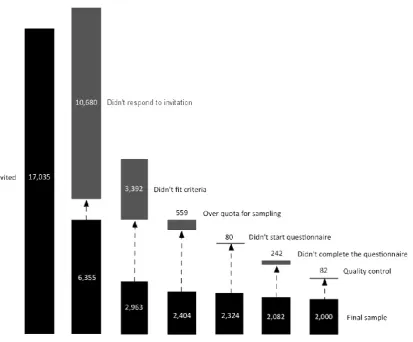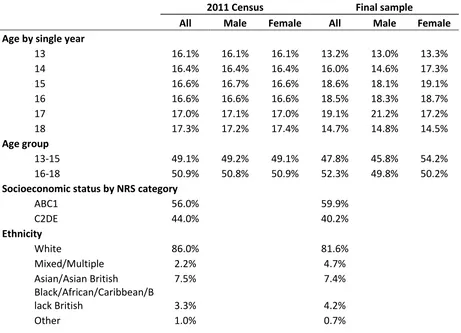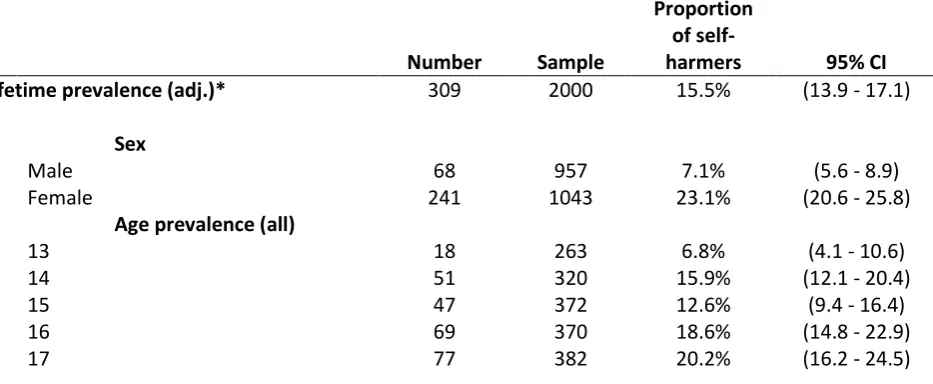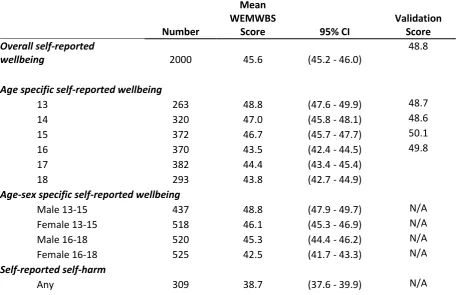Adolescent self-harm in the community: an update on prevalence using a self-report survey of adolescents aged 13 to 18 in England
Yvette Morey1, Dominic Mellon2, Narges Dailami3, Julia Verne4, Alan Tapp1
Yvette Morey, Research Fellow Alan Tapp, Professor of Marketing 1
Centre for the Study of Behaviour Change and Influence,
University of the West of England, Bristol, BS16 1QY, United Kingdom Dominic Mellon, Specialty Registrar in Public Health
2
South Gloucestershire Council, Yate BS37 5AF, UK Narges Dailami, Senior Lecturer
3Faculty of Engineering, Design and Mathematics, University of the West of England, Bristol, BS16 1QY, United Kingdom
Julia Verne, Director Knowledge and Intelligence Team (South West)
4Public Health England, Knowledge & Intelligence, 2 Rivergate, Temple Quay, Bristol BS1 6EH
Abstract
Background To establish an estimate of prevalence in a nationally representative sample of community adolescents. To examine associations between self-harm and wellbeing.
Methods An anonymous self-report survey completed by 2000 adolescents aged 13–18 years across England. Wellbeing was measured using the Warwick-Edinburgh Mental Wellbeing Scale (WEMWBS).
Results In total 15.5 % (n=309) of participants reported ever having self-harmed (95 % CI 13.9–17.1). The median age of onset was 13.0 years. Females aged 13–15 years reported the highest incidence of self-harm within the past year (54.9 %). Cutting elsewhere (other than on the arms) was more prevalent amongst females (56.4 %). The mean wellbeing score for the whole sample (45.6) was lower than the WEMWBS validation score (48.8). Self-harm was associated with a significantly lower wellbeing score, with mean scores of 38.7 (ever self-harmed) and 46.8 (never self-harmed).
Conclusions Self-harm remains prevalent amongst adolescents aged 13–18 years in England. An awareness of the age of peak incidence and risks associated with preferred harming behaviours is crucial during assessment and intervention. The promotion of wellbeing is important for all young people. Further study is needed on the ways in which wellbeing may prevent, or ameliorate, the distress associated with self-harm.
Introduction
In recent years adolescent self-harm has been the focus of increased attention and concern, both in the UK and worldwide.1 Young people’s mental health charities have noted an increase in help sought for self-harm by children and young people.2,3
It has been difficult, historically, to establish prevalence figures for self-harm as studies have made use of different methodologies and definitions which have included or excluded certain behaviours.1,4 Furthermore estimates of prevalence have been dominated by studies based on hospital data and clinical settings, rather than the general population or community. Over the last decade a number of key community studies associated with the multi-country Child and Adolescent Self-Harm in Europe (CASE) study have attempted to address these issues.5 For the purpose of generalisability the present study employs the CASE criteria in which self-harm is defined as:
An act with a non-fatal outcome in which an individual deliberately did one or more of the following:
• Initiated behaviour (for example, self-cutting, jumping from a height), which they intended to cause self-harm.
• Ingested a substance in excess of the prescribed or generally recognised therapeutic dose.
• Ingested a recreational or illicit drug that was an act that the person regarded as self-harm.
• Ingested a non-ingestible substance or object.5,6
No further large-scale community studies were undertaken in England until 2012 when a study using the Avon Longitudinal Study of Parents and Children (ALSPAC) cohort reported a lifetime prevalence of 25.6 % for females and 9.1 % for males.11 Possible reasons for the higher rate of prevalence reported here include: the use of a slightly older age group (16–17 years), a higher proportion of female participants, sampling differences, differences in the wording of questions, and the possibility of an actual increase in prevalence in the intervening period.6,11
Given that only two large-scale community studies of adolescent self-harm have been conducted in England in over a decade, and that only a fraction of adolescents receive help for self-harming,11 there is an ongoing need for community studies which can be compared meaningfully while also identifying emerging issues. Recent literature suggests that young people who cut themselves are not a homogeneous group and that cutting elsewhere on the body (other than on the arms) is more common in females and more closely associated with emotional disturbance, including a stronger likelihood of suicide.12,13 As such, the study aimed to differentiate between cutting on the arms and cutting elsewhere on the body. While previous studies have suggested that self-harm behaviours may start in early adolescence the bulk of prevalence data from studies to date are based on 15–16 year olds.14,15 Consequently the age range of our sample was extended to include 13–18 year olds. Finally, while clinical and community studies of self-harm have focused on the association between self-harm and mental illness or ill-health (e.g. self-harm as a marker for bipolar disorder, associations between self-harm and depression or anxiety) much less is known about the associations between self-harm and wellbeing4.
Methods
Design and setting
The survey employed an anonymous online questionnaire that consisted of 24 items and took 15–30 minutes to complete. It included sections on leisure, lifestyle, and health and wellbeing, in addition to specific questions about self-harm. The study took place between January and August 2013 and the survey was conducted over a 2-week period in April 2013.
Figure. 1 Procedure for the selection of the sample Sample size
An overall sample size for the survey was calculated using Open Source Epidemiologic Statistics for Public Health (OpenEpi) tool for calculating the frequency of events within a population for a random sample.20 Using an expected self-harm prevalence of 14 %, based on existing studies, the recommended sample size required for this study to provide an estimate with a 95 % confidence level was 2055 participants.
Outcome measures
e.g. with fire or a cigarette; swallowed pills or something poisonous; something else, please say what); as well as the incidence of self-harm behaviours (in the last week; in the last year; and more than a year ago). Participants were also asked at what age they first hurt themselves on purpose; a dropdown menu of ages spanning 7–18 years of age was provided for this response. Behaviour was classified as self-harm if it met with the CASE criteria described above. Verbatim descriptions provided by those selecting ‘something else, please say what’ for the type of self-harm were independently coded by Y.M. and D.M. and categorised using the open-coding responses in Hawton, Rodham and Evans.21 Consensus on discrepant cases was reached through discussion with J.V. and A.T.
Wellbeing was measured using the Warwick-Edinburgh Mental Wellbeing Scale (WEMWBS).22 WEMWBS is a 14 item positively worded scale that measures both hedonic (subjective) and eudaimonic (positive functioning) dimensions of wellbeing for populations or groups. It is validated for use by adults and adolescents aged 13 years and upwards. Items are scored using a 1 to 5 Likert Scale and responses are summed to produce a total. The minimum scale score is 14 and the maximum is 70. Mean scores were calculated for the overall sample and sub-groups within the sample. Mean scores by year of age were compared with published validation scores where available.23
Data analysis
SPSS version 20, Microsoft Excel, and Minitab were used to clean, code, and analyse the data. Estimates for lifetime prevalence, as well as prevalence by age, sex, and type of self-harm were calculated. 95 % confidence intervals (CI) were obtained in Minitab using the Clopper-Pearson method. Age-sex prevalence and age-sex incidence ratios were calculated. Analysis of prevalence by social deprivation was measured using the 2010 Index of Multiple Deprivation (IMD) at lower super output area (LSOA).
Ethics
self-harm would increase the risk of future self-self-harm), and obtaining opt-out consent from parents of participants under 16 years of age.
Results
[image:8.595.70.531.432.765.2]In total 2000 adolescents aged 13–18 and living in England participated in the study. A comparison of the mean time from invitation to response for those that reported self-harm behaviour and those that did not showed no significant difference between the two groups. This suggested that a response bias linked to the quota sampling technique used in the study was unlikely: self-harming participants were no more or less likely to have been included in the final sample based on the time taken to complete the questionnaire. A comparative analysis of the sample demographics with population demographics taken from the 2011 census suggested that it was representative in terms of age, gender, socioeconomic status, and geographic distribution as shown in Table 1. The sample included slightly higher proportions for the principal black and minority ethnic groups.
Table 1 A comparative analysis of the sample demographics with population demographics from the 2011 census.
2011 Census Final sample
All Male Female All Male Female Age by single year
13 16.1% 16.1% 16.1% 13.2% 13.0% 13.3%
14 16.4% 16.4% 16.4% 16.0% 14.6% 17.3%
15 16.6% 16.7% 16.6% 18.6% 18.1% 19.1%
16 16.6% 16.6% 16.6% 18.5% 18.3% 18.7%
17 17.0% 17.1% 17.0% 19.1% 21.2% 17.2%
18 17.3% 17.2% 17.4% 14.7% 14.8% 14.5%
Age group
13-15 49.1% 49.2% 49.1% 47.8% 45.8% 54.2%
16-18 50.9% 50.8% 50.9% 52.3% 49.8% 50.2%
Socioeconomic status by NRS category
ABC1 56.0% 59.9%
C2DE 44.0% 40.2%
Ethnicity
White 86.0% 81.6%
Mixed/Multiple 2.2% 4.7%
Asian/Asian British 7.5% 7.4%
Black/African/Caribbean/B
lack British 3.3% 4.2%
2011 Census Final sample
All Male Female All Male Female
Prefer not to say N/A 1.4%
Region
East Midlands 8.6% 8.7%
East of England 11.0% 11.0%
London 15.3% 13.7%
North East 4.9% 3.6%
North West 13.3% 12.9%
South East 16.3% 17.8%
South West 10.0% 12.0%
West Midlands 10.6% 9.4%
Yorkshire 10.0% 11.0%
Prevalence
[image:9.595.81.548.582.774.2]Overall 15.5 % (n=309) of all participants reported a history of self-harm in their lifetime (95 % CI 13.9–17.1). The prevalence for females (23.1 %, 95 % CI 20.6–25.8) was much higher than it was for males (7.1 %, 95 % CI 5.6–8.9). Looking across single age groups, the highest prevalence was found for 16 year olds (18.6 %, 95 % CI 14.8–22.9) and 17 year olds (20.2 %, 95 % CI 16.2–24.5), with the lowest prevalence found for 13 year olds (6.8 %, 95 % CI 4.1– 10.6). Grouped by age-sex ratio the highest lifetime prevalence was found for females aged 16–18 years (29.0 %, 95 % CI 25.1–33). The highest incidence (self-harm within the last year) was reported by females aged 13–15 years (54.9 %, 95 % CI 44.2–65.4). Full findings for prevalence, incidence and type of behaviour are shown in Table 2.
Table 2 Prevalence of self-harm reported by lifetime history, sex, age, sex ratios, age-sex incidence and type of behaviour.
Number Sample
Proportion of
self-harmers 95% CI Lifetime prevalence (adj.)* 309 2000 15.5% (13.9 - 17.1)
Sex
Male 68 957 7.1% (5.6 - 8.9)
Female 241 1043 23.1% (20.6 - 25.8)
Age prevalence (all)
13 18 263 6.8% (4.1 - 10.6)
14 51 320 15.9% (12.1 - 20.4)
15 47 372 12.6% (9.4 - 16.4)
16 69 370 18.6% (14.8 - 22.9)
18 52 293 17.7% (13.5 - 22.6)
Age-sex prevalence (male and female)
Male 13–15 24 437 5.5% (3.6 - 8.1)
Female 13–15 89 518 17.2% (14 - 20.7)
Male 16–18 44 520 8.5% (6.2 - 11.2)
Female 16–18 152 525 29.0% (25.1 - 33)
Age-sex incidence (self-harm within the past year)
Male 13–15 10 25 40.0% (21.1 - 61.3)
Female 13–15 50 91 54.9% (44.2 - 65.4)
Male 16–18 16 44 36.4% (22.4 - 52.2)
Female 16–18 67 154 43.5% (35.5 - 51.7)
Type of self-harm behaviour
Cut on arms 232 309 75.1% (69.9 - 79.8)
Cut elsewhere 167 309 54.0% (48.3 - 59.7)
Self-battery 159 309 51.5% (45.7 - 57.2)
Pills or overdose 88 309 28.5% (23.5 - 33.9)
Burnt 66 309 21.4% (16.9 - 26.4)
*Total adjusted from 314 to 309 as 5 participants did not meet the study criteria for self-harm
While prevalence estimates varied between ethnic groups, the only statistically significant difference for the reporting of a lifetime history of self-harm was between participants with a White background (16.3 %) and those with an Asian background (6.8 %). Analysis of prevalence by social deprivation showed little variation and there were no statistically significant differences between quintiles of deprivation.
Age of onset
Based on the self-report data for the question “At what age did you first hurt yourself on purpose?” the median age of onset was calculated as 13.0 years and there was no statistically significant difference in mean age of onset between males (13.5) and females (13.0). The most common (modal) age of onset was 14 years (24 %), with nearly half of those that self-harmed starting between 13 and 15 years of age.
Type of self-harm
most common behaviour for males (60.3 %, 95 % CI 47.7–72.0). Taking pills or an overdose was reported by more male (39.7 %, 95 % CI 28.0–52.3) than female (25.3 %, 95 % CI 19.9– 31.3) participants.
Wellbeing
[image:11.595.72.529.464.759.2]The mean wellbeing score for the whole sample (45.6) was significantly lower than the WEMWBS validation score (48.8). The lowest scores for single age groups across the whole sample were found for 16 (43.5) and 18 year olds (43.8). Grouped by age-sex ratio the lowest wellbeing score was found for females aged 16–18 years (42.5). Self-harm was associated with a significantly lower wellbeing score, with mean scores of 38.7 (ever self-harmed) and 46.8 (never self-self-harmed). There was little variation in wellbeing scores when measured against different types of harm, the lowest mean score for the type of self-harm behaviour was observed in the pills/overdose subgroup (36.7). Full wellbeing scores are shown in Table 3 below.
Table 3 Overall self-reported wellbeing and validation score, age specific wellbeing, age-sex ratios, wellbeing scores for a lifetime history of self-harm and type of self-harm behaviour.
Number
Mean WEMWBS
Score 95% CI
Validation Score
Overall self-reported
wellbeing 2000 45.6 (45.2 - 46.0)
48.8
Age specific self-reported wellbeing
13 263 48.8 (47.6 - 49.9) 48.7
14 320 47.0 (45.8 - 48.1) 48.6
15 372 46.7 (45.7 - 47.7) 50.1
16 370 43.5 (42.4 - 44.5) 49.8
17 382 44.4 (43.4 - 45.4)
18 293 43.8 (42.7 - 44.9)
Age-sex specific self-reported wellbeing
Male 13-15 437 48.8 (47.9 - 49.7) N/A
Female 13-15 518 46.1 (45.3 - 46.9) N/A
Male 16-18 520 45.3 (44.4 - 46.2) N/A
Female 16-18 525 42.5 (41.7 - 43.3) N/A
Self-reported self-harm
Number
Mean WEMWBS
Score 95% CI
Validation Score
None 1691 46.8 (46.3 - 47.3) N/A
Self-reported self-harm by type
Cut on arms 235 37.9 (36.6 - 39.2) N/A
Cut elsewhere 170 37.4 (35.9 - 38.9) N/A
Self-battery 163 38.1 (36.5 - 39.6) N/A
Burnt 68 37.0 (34.4 - 39.7) N/A
Pills or overdose 89 36.7 (34.3 - 39.0) N/A
Something else 24 38.8 (34.7 - 43.0) N/A
None 1691 46.8 (46.3 - 47.3) N/A
Discussion
Main finding of this study
Self-harm is prevalent amongst adolescents aged 13–18 in years England. The prevalence estimate of 15.5 % is largely commensurate with existing prevalence estimates. Prevalence rates were higher for older participants (20 % of 17 year olds across the whole sample, and 29.0 % of females aged 16–18 years), however the median age of onset (13.0 years) and peak incidence rates for females aged 13–15 years point to the importance of considering lifetime prevalence alongside age of onset and incidence in order to arrive at a fuller understanding of adolescent self-harm.
What is already known on this topic
The findings confirm that self-harm is more prevalent amongst females and that cutting is the most common type of self-harm in community samples. Our findings lend support to recent suggestions that females are more likely to cut themselves elsewhere.12,13 Given the heightened risks associated with this, this finding highlights the importance of differentiating cutting behaviour in studies of self-harm. This differentiation is also crucial for the assessment of young women who cut elsewhere.
What this study adds
The use of a nationally representative sample and the same set of criteria for defining self-harm means that the findings are generalisable and can be meaningfully compared with significant studies in the area.6,11
To our knowledge this the first large-scale community study to examine associations between self-harm and wellbeing. A lifetime history of self-harm was associated with a significant reduction in wellbeing. Additionally, lower mean scores for wellbeing were recorded for the whole sample, with the lowest scores recorded for females aged 16–18 years. Correspondingly, the highest estimate of prevalence (29.0 %) was observed for this subgroup. Given the complex and multiple determinants of self-harm the promotion and bolstering of wellbeing in all young people may ameliorate the need for adverse coping strategies and foster the resilience needed to cope with emotional distress.
In addition to the attainment of a nationally representative sample of adolescents, the use of a market research panel ensured a speedier and more cost-effective data collection process than might normally have been the case. Panel-based surveys minimise some of the risks, such as under-reporting and absenteeism, associated with school-based sampling.
Limitations of this study
As the study is cross-sectional it only provides a snapshot of prevalence and points to correlation rather than causation. The findings are largely descriptive and based on univariate analysis, however the study has produced a large body of data for secondary analysis.
While the response rate is commensurate with response rates for leading market research panels we acknowledge that adolescents experiencing severe emotional distress associated with self-harm or other mental health problems might not have been able to participate in or complete a survey.
The survey was completed prior to the GCSE and A Level examinations and it is possible that lower wellbeing scores for 16 and 18 year olds reflected this.
This work was supported by the South West Public Health Observatory and National Health Service (NHS) South of England Strategic Health Authority. Following the implementation of the Health & Social Care Act 2012 on 1 April 2013 additional project costs were met by the Public Health England South West Knowledge and Intelligence Team.
Acknowledgements
We thank the following for advice and assistance: Professor David Gunnell, Dr Judi Kidger, Salena Williams, Anthony Harrison, the Suicide and Self-Harm group at the University of Bristol, the Self-Injury Network group (SING) and Hilary Lindsay at the Bristol Crisis Service for Women (BCSW), Suzanne Pearson and volunteers at the Self-Injury Self-Help (SISH) group, and Professor Jane Powell.
References
1. Muehlenkamp JJ, Claes L, Havertape L, Plener PL. International prevalence of
adolescent non-suicidal self-injury and deliberate self-harm. Child Adolesc Psychiatry
Ment Health 2012;6(1):10.
2. Brophy M. Truth Hurts: Report of the National Inquiry into Self-harm among Young
People. Mental Health Foundation; 2006. Available from:
http://www.mentalhealth.org.uk/content/assets/PDF/publications/truth_hurts.pdf
3. ChildLine. Can I Tell You Something? What’s Affecting Children In 2013. Childline; 2013. Available from: http://www.nspcc.org.uk/news-and-views/media-centre/press-
releases/2014/childline-report/childline-report_can-i-tell-you-something_wdf100354.pdf
4. McDougall T, Armstrong M, Trainor G. Helping Children and Young People who Self-harm: An Introduction to Self-harming and Suicidal Behaviours for Health
Professionals. Abingdon: Routledge; 2010.
5. Madge N, Hewitt A, Hawton K, de Wilde EJ, Corcoran P, Fekete S, et al. Deliberate self-harm within an international community sample of young people: comparative findings from the Child & Adolescent Self-harm in Europe (CASE) Study. J Child Psychol
6. Hawton K, Rodham K, Evans E, Weatherall R. Deliberate self harm in adolescents: self report survey in schools in England. Br Med J 2002;325:1207–11.
7. Morey C, Corcoran P, Arensman E, Perry IJ. The prevalence of self-reported deliberate self harm in Irish adolescents. BMC Public Health 2008;8:79.
8. O’Connor RC, Rasmussen S, Miles J, Hawton K, Connor RCO. Self-harm in adolescents: self-report survey in schools in Scotland. Br J Psychiatry 2009;194(1):68–72.
9. De Leo D, Heller TS. Who are the kids who self-harm? An Australian self-report school survey. Med J Aust 2004;181(3):140–4.
10. O’Connor RC, Rasmussen S, Hawton K. Adolescent self-harm: a school-based study in Northern Ireland. J Affect Disord 2014;159:46–52.
11. Kidger J, Heron J, Lewis G, Evans J, Gunnell D. Adolescent self-harm and suicidal thoughts in the ALSPAC cohort: a self-report survey in England. BMC Psychiatry 2012;12(69).
12. Klonsky ED, Olino TM. Identifying clinically distinct subgroups of self-injurers among young adults: a latent class analysis. J Consult Clin Psychol 2008;76(1):22–7.
13. Laukkanen E, Rissanen M-L, Tolmunen T, Kylmä J, Hintikka J. Adolescent self-cutting elsewhere than on the arms reveals more serious psychiatric symptoms. Eur Child
Adolesc Psychiatry 2013;22(8):501–10.
14. Glenn CR, Klonsky ED. Social context during non-suicidal self-injury indicates suicide risk. Pers Individ Dif 2009;46(1):25–9.
15. Hargus E, Hawton K, Rodham K. Distinguishing between subgroups of adolescents who self-harm. Suicide Life Threat Behav 2009;39(5):518–37.
16. ResearchBods. Esomar 26 Panel Quality and Procedures. Available from: http://www.researchbods.com/downloads/Esomar26.pdf
17. Ipsos Mori. Ipsos Online Access Panels; 2012. Available from: https://www.ipsos-mori.com/Assets/Docs/Techniques/ESOMAR-26-Questions.pdf
http://www.dignityindying.org.uk/wp-content/uploads/2013/12/DADiD-poll-2013.pdf
19. Nancarrow C, Tapp A. Online access panels for surveys public health and
epidemiology. Discussion Paper: University of the West of England; 2014. Available
from: http://eprints.uwe.ac.uk/23013
20. OpenEpi [Internet]. Available from: http://www.openepi.com/Menu/OE_Menu.htm 21. Hawton K, Rodham K, Evans E. By their own young hand: deliberate self-harm and
suicidal ideas in adolescents. London: Jessica Kingsley Publishers; 2006.
22. Clarke A, Friede T, Putz R, Ashdown J, Martin S, Blake A, et al. Warwick-Edinburgh Mental Well-being Scale (WEMWBS): validated for teenage school students in England and Scotland. A mixed methods assessment. BMC Public Health 2011;11(1):487.
23. Stewart-brown S, Janmohamed K, Parkinson J. Warwick-Edinburgh Mental Well-being
Scale User Guide. Warwick: Warwick Medical School; 2008.



